Of the myriad artists who have painted Venice, Turner is the most wonderful. Her influence on him cannot be stated in words: after his first residence in Venice, in the early eighteen-thirties, when he was nearing sixty, his whole genius became etherealized and a golden mist seems to have swum for ever before his eyes. For many years after that, whenever he took up his brush, his first thought was to record yet another Venetian memory. In the Tate Gallery and the National Gallery are many of the canvases to which this worshipper of light endeavoured with such persistence and zeal to transfer some of the actual glory of the universe: each one the arena of the unequal struggle between pigment and atmosphere. But if Turner failed, as every artist must fail, to recapture all, his failures are always magnificent.
There are, of course, also numbers of his Venetian water-colours.
Where Turner lived when in Venice, I have not been able to discover; but I feel sure it was not at Danieli’s, where Bonington was lodging on his memorable sojourn there about 1825. Turner was too frugal for that. The Tate has a brilliant oil rendering of the Doges’ Palace by Bonington. The many Venetian water-colours which he made with such rapidity and power are scattered. One at any rate is in the Louvre, a masterly drawing of the Colleoni statue.
To enumerate the great artists who have painted in Venice would fill a book. Not all have been too successful; while some have borne false witness. The dashing Ziem, for example, deprived Venice of her translucency; our own Henry Woods and Luke Fildes endow her daughters, who have always a touch of wistfulness, with too bold a beauty. In Whistler’s lagoon etchings one finds the authentic note and in Clara Montalba’s warm evanescent aquamarines; while for the colour of Venice I cannot remember anything finer, always after Turner, than, among the dead, certain J.D. Hardings I have seen, and, among the living, Mr. Sargent’s amazing transcripts, which, I am told, are not to be obtained for love or money, but fall to the lot of such of his friends as wisely marry for them as wedding presents, or tumble out of his gondola and need consolation.
Bonington and Harding painted Venice as it is; Turner used Venice to serve his own wonderful and glorious ends. If you look at his “Sun of Venice” in the National Gallery, you will not recognize the fairy background of spires and domes—more like a city of the Arabian Nights than the Venice of fact even in the eighteen-thirties. You will notice too that the great wizard, to whom, in certain rapt moods, accuracy was nothing, could not even write the word Venezia correctly on the sail of a ship. Whistler too, in accordance with his dictum that to say to the artist that he must take nature as she is, is to say to the musician that he must sit on the piano, used Venice after his own caprice, as the study of his etchings will show. And yet the result of both these artists’ endeavours—one all for colour and the other all for form—is by the synthesis of genius a Venice more Venetian than herself: Venice essentialized and spiritualized.




